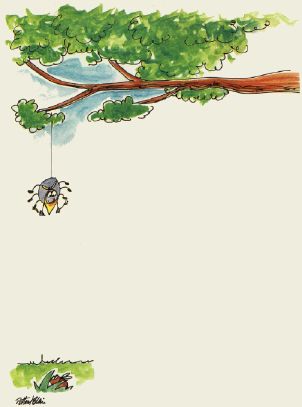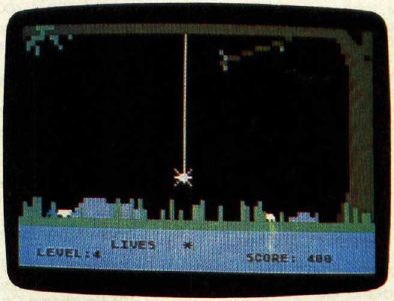Webster Dines Out
Walter Bulawa

Tired of blasting invaders from outer space? This whimsical game is set in a very different world—the miniature jungle in your own backyard. The original version was written for the Atari. We've added versions for Apple, TI, Commodore 64, VIC-20, and IBM PC and PCjr computers. A joystick is required for the Atari and Commodore 64 versions.
Guide Webster, the hungry tree spider, in his endless search for a square meal. Roving back and forth across his tree limb, he watches for bugs to appear in the grass below. When the time is right, he drops down on a strand of silk for a light snack, then climbs back up his web to look for more.
Unfortunately, this backyard paradise isn't quite perfect. The more Webster eats, the faster the bugs move, making it harder to find the next meal. Even worse, he's not the only one with an appetite—there's a speedy scorpion sharing the same hunting ground, stealing bugs when he can and giving Webster a sting whenever he drops too close.
Atari Version
Program 1—the Atari version of "Webster Dines Out"—will run on any Atari computer with at least 32K memory. Use the joystick to move Webster left or right at the top of the screen. When a bug passes below, press the button to make him drop down.
Your goal is to score points as quickly as possible. Each bug is worth 25 points and you get 50 bonus points for snaring two bugs in a single drop. Webster has three lives in each game; getting stung by the scorpion costs you a life but does not reduce your score. The scorpion is a tough competitor: When Webster drops down, the scorpion speeds up to increase his chances of stealing a bug.
There are six skill levels, each harder than the last. As you advance to higher levels, the bugs and scorpion speed up, the grass grows longer, and a grey rock appears in the lawn. The other creatures hide behind these objects, but Webster can drop behind them too. The game ends when you lose all three lives or exhaust your time at the highest skill level.
Commodore 64 And VIC-20 Versions
Both Commodore versions of Webster Dines Out are scored like the Atari game—25 points for each bug, with a 50 point bonus for capturing two at once. You begin with three lives, and lose one each time you collide with the scorpion.
The 64 version (Program 2) is played with a joystick in port 2. The bugs and scorpion move across a sloping, multicolored lawn; at higher skill levels, colorful objects grow up to obscure your view of the ground. Play ends when your lives are used up or time runs out at the last skill level.
The VIC-20 version of Webster Dines Out is written in machine language (ML) for the unexpanded VIC. Program 3 is a BASIC loader that saves the ML program on disk or tape. Since the loader won't fit in an unexpanded VIC, you'll need at least 8K memory expansion to run it (a Commodore 64 can also be used; see instructions below). Type in and save Program 3, but don't try to run it yet. Enter this line in direct mode (without a line number):
POKE 6609, 0: POKE 43, 209: POKE 44, 25: NEW
Now reload Program 3 and run it. Press D to save the game on disk, or T to save it on tape. The finished program will be named WEBSTER (replacing any other program of that name on your disk). If you don't have memory expansion, you can use a Commodore 64 to create the VIC game (of course, the game itself runs only on a VIC). To run the loader on a 64, change the 57809 to 57812, and 63109 to 62957 in lines 9-11 of Program 3. Then follow the procedure described above.
Once the game is saved, remove any memory expansion and load and run it like a BASIC program. Move Webster with the < and > keys, and drop him down by pressing the space bar. As you progress to higher skill levels, the speed increases, and rocks appear below, blocking your vision. You can snare bugs from behind the rocks, but be careful not to drop onto a hidden scorpion. Play continues until you lose all three lives.
IBM Version
Program 4 runs on any PCjr with cartridge BASIC and any IBM PC with BASICA and a color/graphics adapter card. Press the left and right cursor keys to move Webster, and the space bar to drop.
Webster's lifeline is displayed at the top of the screen. When you drop to get a bug, your energy level is drained and your lifeline shrinks. Capturing a bug restores your energy and expands your lifeline. You'll score 10 points for catching a beetle, and 20 for each bug, with bonus points for multiple captures. Extra bonus points are awarded at the 1,000, 5,000 and 10,000 point marks. As your score increases, the bugs speed up and become more scarce; your energy will drain faster, too. The game ends when you hit the scorpion or your energy drains to zero.
Apple Version
This version of Webster Dines Out will run on any Apple II series computer. Since it's written entirely in machine language (ML), it must be entered using the "Apple MLX" machine language editor found elsewhere in this issue. MLX will greatly simplify the usually tedious job of accurately entering the many numbers that make up a ML program. But be sure that you read the MLX article and understand how to use MLX before you begin entering the data from Program 5.
When you run MLX, it will ask for a starting and ending address. Use the values indicated in Program 5:
START ADDRESS? 1100 END ADDRESS? 1F14
MLX will then give you a menu of options. Choose E for enter and give 1100 as the starting address. A prompt for the first line will appear, and you can begin entering the data from Program 5. If you don't type the entire listing in one sitting, follow the instructions in the MLX article for saving a partially complete version and reloading it later. When you're finished typing, MLX will prompt you for a filename for the completed machine language program. To load and run the game, simply type BRUN "WEBSTER" (or whatever name you used for the completed program) and press RETURN.
The scoring is identical to the Atari version. Use the left and right arrow keys to move on the branch, and press the space bar to drop to the ground. Avoid colliding with the giant grasshopper—when that happens, Webster loses a life (and is carried bodily off the screen). The grass in the lawn grows higher as the game progresses, making your job more difficult. You can drop into the grass to snare a hidden bug, but be sure to keep track of the giant hopper, who might be lurking there as well.
TI Version
This version of Webster (Program 6) uses sprites for the spider, bugs, and scorpion, and thus requires TI Extended BASIC. You can use either joystick or keyboard controls. For the keyboard, press the S key to move left, the D key to move right, and the space bar to make Webster drop. Scoring is identical to the Atari version: You have three lives in each game, and six possible levels. Bugs are worth 25 points, with a 50 point bonus for catching two at once.
At the bottom of the screen you'll see Webster's lifeline. Dropping for a bug drains your energy and shrinks the lifeline; catching a bug restores your energy to normal. You lose a life whenever your energy drains to zero or you hit the scorpion. The game will not end until you lose all three lives.
